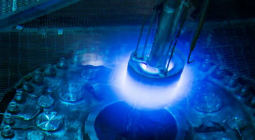Plan to dispose of nuclear waste from Aukus submarines unanimously rejected by Adelaide council
City of Port Adelaide Enfield’s mayor says she hadn’t received correspondence about storage or disposal before or after bill passed federal parliament
Plans to dispose of low-level nuclear waste from Aukus submarines at an Adelaide naval facility have been unanimously opposed by the local council for the area, who say they weren’t consulted.
The Osborne naval shipyard, 25km north of Adelaide CBD, and HMAS Stirling at Garden Island 50km south of Perth in Western Australia, have both been designated as “radioactive waste management facilities” for nuclear waste from Aukus submarines under the Australian naval nuclear power safety bill, which passed parliament in October.
Last week, the City of Port Adelaide Enfield – responsible for the area surrounding the Osborne shipyard – voted to unanimously oppose the storage and disposal of radioactive waste at the site.
Its mayor, Claire Boan, said council had been briefed on aspects of the Aukus project but it had not received any correspondence or communication about management and disposal of nuclear waste at the site.
“While the decision-making regarding this is out of the control of the council, we will continue to advocate for our community and lobby for community consultation throughout the process,” she said.
Rex Patrick, a former independent senator for South Australia, said the situation highlighted the lack of consultation and transparency regarding Aukus nuclear waste.
“Albanese called for Dutton to disclose where he was going to put his nuclear power reactors, and yet there’s been complete secrecy around the entire process associated with where they’ll put the high-level waste from naval reactors,” he said.
No public announcements have been made about the site selection or consultation process for dealing with the high-level nuclear waste associated with the Aukus submarines, which the government agreed Australia would dispose of in March last year.
While the type of radioactive waste to be managed at the Osborne shipyard was not detailed in the legislation, the health minister, Mark Butler, the Labor member for Port Adelaide and Hindmarsh, told the ABC that it would be low-level material.
A spokesperson for the deputy prime minister, Richard Marles, said submarine construction, test and commissioning activities planned for Osborne would generate “small amounts” of low-level waste like gloves, wipes or personal protective equipment that would need to be managed and temporarily stored at the site.
“No intermediate-level or high-level radioactive waste (spent nuclear fuel) will be managed or stored at HMAS Stirling or the Osborne Submarine Construction Yard facilities,” the spokesperson said.
Nigel Marks, an associate professor and nuclear scientist at Curtin University, said low-level nuclear waste was “radioactive, but not dangerous”.
There wasn’t usually consultation for managing low-level material at other facilities like hospitals or in industry, he said, noting “you’d never get away with an intermediate or high-level waste repository without hardcore community engagement”.
The uncertainty surrounding the storage of intermediate and higher-level nuclear waste from the Aukus submarines didn’t help, he said.
He said the government could get on the front foot by explaining the site selection pathway and consultation process for dealing with the high-level nuclear waste from Aukus.
“That’d be smart politics, good science,” he said. “It’ll take a little while to do that, but there’s definitely precedent in Finland or Sweden for how you should manage it.”
Cover photo: By The Guardan




